It is tempting for us to interpret our dog’s behavior using human values. We may get angry because we think our dog is misbehaving out of meanness, spite, or vengeance. We may get sad or frustrated because we interpret bad behavior as a rejection of our love.
However, dogs do not think like us, and they have different social rituals and instincts. As a result, bad dog behavior commonly arises due to miscommunication and misunderstanding between human and dog.
The best way I have found to help stop my dog’s bad behavior is to learn how to “see” and “speak” dog. The more I observe and try to understand where my dog is coming from, the more effective I am at teaching him how to get along well with the people and animals around him.

Step 1 – Identify the source of the bad dog behavior
To do this, we must stay objective and focused, even though we may not always like the answers that we find. It helps to find a professional dog trainer or a dog expert at this stage.
A dog trainer has no emotional stake in the situation and has more experience with reading dogs.
This allows him to more quickly and accurately identify the problem source. Bad behaviors commonly get intensified when owners misdiagnose a problem, and subsequently try to address it in the wrong way.
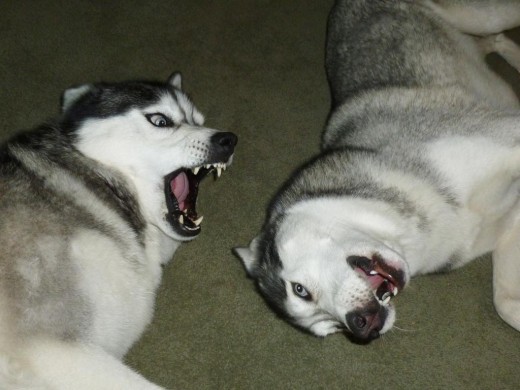
Here are some important questions I ask while trouble-shooting my dog’s undesirable behaviors.
What?
What triggers the behavior?
Is it large dogs, small dogs, dogs with long hair, dogs with floppy ears, or all of the above?
Is it just dogs, or is it also cats, squirrels, children, old people, people wearing weird hats, people carrying umbrellas, bicycles, skate boards, or something else?
Why?
Why is my dog showing this behavior?
Is it due to fear of dogs, dislike of people, excitement, or dominance? I listen to my dog by carefully observing his body posture, and what causes changes in that body posture.
A fearful dog will try to make himself look small, and shrink away into a corner, or behind objects and other barriers. His tail or head may be down, and he may be showing signs of stress. In contrast, a dominant dog will usually have ears erect, tail up, chest out, and a forward looking posture.
It can be difficult to read a dog because the change in body language may be slight (twitch of the mouth, sway of the tail), and brief.
Some dogs may switch body language quickly, and others may ramp up to dog aggression before we can react.

Step 2 – Retrain the bad dog behavior

a) Do not reward bad behavior.
Some behaviors develop because we inadvertently reward our dogs for them.
For example, when a dog jumps on us, we usually push him back with our arms and hands. This rewards the jumping behavior by giving the dog what he wants, i.e. our attention and a fun game of arm wrestling.
Similarly, we may give our dog more attention when he barks, whines, or vocalizes. This rewards the vocalization, thereby making the dog more likely to repeat those behaviors.
When my dog is showing undesirable behaviors, I either redirect him, ignore him, or put him on a time-out (i.e., temporarily withdraw his freedom).
b) Stay calm and in control during bad dog behavior.
When dealing with a bad dog situation, it is difficult but necessary to stay calm and in control.
Dogs can easily sense our inner energy through scent and sound. When we get angry, frustrated, or otherwise unbalanced, our dog will detect that, and become even more frantic. The only way to calm him down, is to stay calm and in control of the situation ourselves.
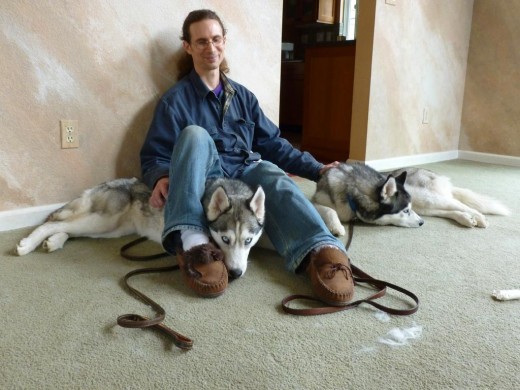
c) Redirect the bad dog behavior.
When a dog does something bad, we want to communicate to him that this behavior is undesired by us. I use a consistent no-mark such as No or Ack-ack. However, do not make the mistake of just stopping there.
We should always try to follow up the no-mark with a positive behavior.
For example, after saying No,
- I ask my dog for a Sit or Spin,
- I encourage him to play with a toy, or
- I tell him to go to his bed.
Which redirection we use will depend on the temperament of the dog, what the dog knows, and the situation at hand.
I mark (Yes) and reward my dog well with treats and praise when he stops his bad behavior, and redirects onto the new activity. If we are consistent with our redirection and rewards, our dog will learn to perform the positive behavior on his own because it gets him good results.
For redirection to work, we must stop our dog before he escalates his bad behavior.
If we let him escalate his behavior, he may get too frantic or excited to listen to us. Once in this state, it is best to remove him from the problem stimulus. Sometimes, a stimulus may be so strong that a dog escalates very quickly, and it may not be possible to redirect him onto something else.
In these situations, I find that it is best to first practice controlled desensitization exercises with my dog.

d) Desensitize our dog to the problem stimulus.
Flooding
Instead of dog desensitization, some trainers may use flooding. With flooding, we expose the dog to large doses of the bad stimulus, and force him to endure it until he stops being frantic or afraid.
Flooding is a common technique used by Cesar Millan, in his Dog Whisperer program.
The advantage of flooding is that it can bring faster results. The danger of flooding, is that it can cause a dog to totally break down and become even more psychologically damaged than before.
Imagine locking a claustrophobic patient in a small room with his psychiatrist until he snaps out of it. Either he gets better really quickly, or he totally snaps. It is best NOT to use flooding techniques because it can be risky and dangerous.
Desensitize our dog to a stimulus, by first exposing him to very low levels of the stimulus, under supervision.
For example. if my dog is aggressive toward other dogs, I can start desensitizing him with a very calm dog, that is not moving (e.g. in a Sit position), that is not focused on my dog (no eye-contact), and from a far enough distance. If my dog is reactive to the sound of thunder, I can start desensitizing him with a very low volume recording of thunder.
I only practice desensitization exercises in a quiet area, where I am in control of the environment.
- I start with a low level stimulus that my dog is able to tolerate, i.e. he is able to stay calm and listen. For example, I may position him some distance away from the “other dog” stimulus, in order to weaken it.
- I get his attention by calling his name, then reward him for giving me his attention and for staying calm. I can also ask him for other simple commands such as Sit, Touch, or Watch.
- Once I am comfortable with this, I very slightly increase the strength of the stimulus. For example, I may move one step toward the other dog.
- Then, I stop and get my dog’s attention again.
If my dog starts to react, then I have moved forward too quickly. I move back a few steps and restart the exercise.
I keep sessions short and rewarding so that my dog will begin to build confidence with each successful session, and learn to associate positive rewards with the previously bad stimulus.
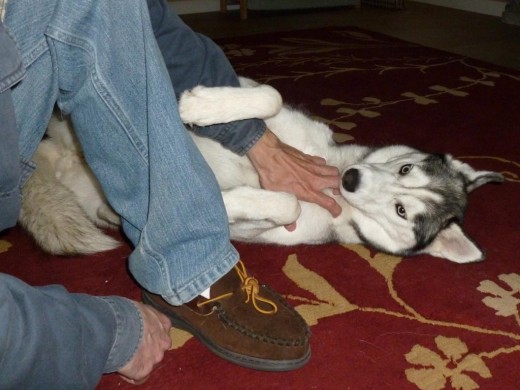
e) Set our dog up for success.
Remember to always set our dog up for success and keep him from repeating bad behaviors.
I properly manage my dog so that he is not constantly exposed to stressful stimulus that cause him to act badly. The more he practices the undesirable behavior, the harder it will be to stop that behavior.
I craft my retraining process to suit the temperament of my dog. In general, I focus on one or two bad behaviors at a time, so that neither me or my dog will become overwhelmed.
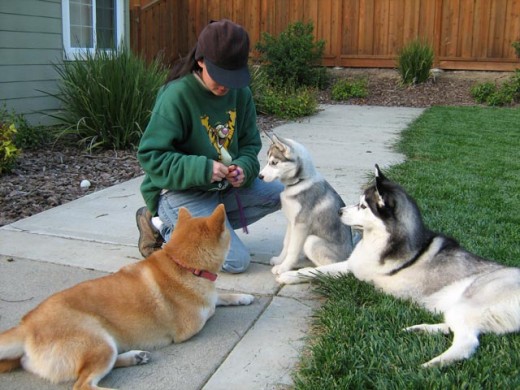
Step 3 – Prevent future bad dog behavior

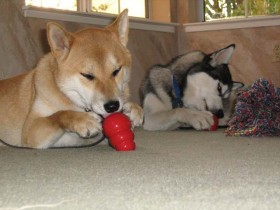
One of the best ways to prevent future bad behavior, is to provide our dog with many interesting, sanctioned activities and toys.
Many dogs resort to undesirable behaviors because they are bored. If we do not provide acceptable activities for our dogs, they are left to devise their own activities, which rarely appeal to our human sensibilities.
A dog who is well-exercised, both mentally and physically, is happy to just lie around and turn over for belly-rubs. A dog who is cooped up all day, with no company, and no activity, will be very frustrated and destructive. He may chew up our house, bark, charge the fence, escape, or perform a variety act from the “bad dog greatest hits album”.
This will end up costing us a lot of time, money, and emotional stress.
If we are busy during the day, consider dog daycare or dog walking. This gives our dog something interesting to do, and helps him brush up on his social skills with a variety of people and dogs. The rewards we receive will more than outweigh the costs, because instead of coming home to a chewed up house, we will be greeted by a tired and happy dog that just wants to rest beside us.

My girl dog just died but we kept one of her pups. Almost 4 now he seems to be learning out of nessitity. ( Can’t spell) But he is very scared of people and other dogs. Aggressive behavior we would like to fix.
Hello! I was wondering if you had any advice for this situation…I have a 7 month old Shiba Inu. She is very smart and knows what she is allowed and not allowed to do. I know she knows because if she does it and I look at her she runs away into a fit of zoomies. The problem is that if she has something that I need to take away from her or her “crime” was enough to warrant a time out, I can never get her with ease because she will run under the bed where I can’t reach her. This is with me just walking over to her. She knows she was bad! I’ve tried sitting on the floor and waiting her out. Or calmly calling her to come out but she won’t listen and won’t come out until I leave the room. How can I stop her from retreating under the bed? Any ideas?
I got my half husky half Sheppard from a dog shelter over the last eight months he’s become a bully to my other dog he doesn’t listen he jumps in front of the other dog when ever he gets pet or gets a treat he jumps on me and I can’t walk him it’s impossible he does whatever he wants he poops in the house and pees on my carpet he is like getting me back for something he attacks other dogs too help
Hello,
I have a one-year-old Shiba that I have owned for four months. I work from home 3x days a week and go into the office 2x a week. On one of the days I go into the office I take him to doggy daycare and the other day I leave him at home and a dog walker will take him. On the days I leave him at home for the dog walker, he destroys the house until she arrives. Even when I leave nothing of mine around and provide chew toys and treats he still finds something of mine to destroy. I’ve tried to leave him at home for one to two hours in the evening and the same result. I’m having a hard time not being able to leave him alone at all as I have errands, work and things I need to get done and can’t afford doggy daycare every single time. I tried crate training and that did not go well. He chewed through the bars and did the Shiba scream and whining the entire time I was away. I know he requires exercise and mental stimulation but he destroys the house even on the days that I provide this. He simply refuses to be left alone, any recommendations?
That sounds a lot like separation anxiety. For some dogs, it can be extreme. There are many articles and books about this, and I would consider getting a positive based trainer, especially one with Shiba experience, to help with this. I did desensitization exercises with my Shiba when he was very young to get him accustomed to alone time. He is ok with it as long as it is according to a fixed routine. When it is out of routine, he still gets a bit stressed.
https://shibashake.com/dog/separation-anxiety-dog-why-how-reduce-dog-stress#desensitize
I also set up a safe play-pen space for my Shiba when he is alone so he can’t run around and cause damage to himself. He has some arthritis now, so I don’t want him jumping and running around too much. I connect together multiple play-pens so it is a large but safe space. Some dogs may do better with a larger space compared with a crate, but it is something that I would test on for very short periods of time at first. Desensitization is also very helpful for a pup to get used to a crate or play-pen.
Hi, my 4 year old terrier is constantly barking, peeing, and taring my things up. Can you give me some advise to STOP this.
Hi, Bobbie my two year male dog come to me when he was eight months old, he came from a bad home. Everyone loves him and he behaves for every one but me. Mr problems begin when I am leaving him mad sometimes when I am putting his lead on. He jumps up and has sometimes left his teeth marks on me.when I come home he is so pleased to see me, a different dog .this only me he does it with and I live alone with him . He his a great the rest of the time, I love him .can you HELP please.
Hi,
I live in Coimbatore in South India. We hardly have any good dog trainers here. If at all there are, they have no time for my 1 year old German spitz. My problem is that we are first time pet parents. So we worked from the heart more than the mind and now he’s quite spoilt. The concern now is that he’s become very aggressive. He bites even house members if we try to make him do anything he doesn’t want to. It’s now getting out of control. Also his peeing used to be in 1 place and in the recent few days he does it wherever he feels like. I’m just losing it. Please help me. I’m banking a lot on this.
Hi,
My fiance and I just got a 3-month old shiba (Oni). And he has been with us for 3 days. I am so happy I found this helpful website of yours.
The first 2 days, he was a very good pup to my surprise since I read a little bit about shiba and is aware how challenging shiba can be. He peed on his puppy pad, followed us and listened to our call even when we were at the park and he was on a dragging flat leash.
Starting on the 3rd day (yesterday), he got comfortable and started acting like a puppy, chewing things, running around, stealing fluffy rugs from our bedroom (we found it adorable and funny), barking playfully at our 9yr old doxie. So I guess he passed his honeymoon phase.
1 thing I found annoying is he pees every time he gets into a carpeted area (bed room and office rooms). He is very good peeing on puppy pad and outside when we take him. But right when he gets access to a carpeted area he starts peeing.
If he does not get access to the carpet, he will get up and go to the pee pad to pee.
Is there a good way to fix this behavior? I tried taking him out, spraying bitter water on the carpet, and cleaned the carpet with enzyme breaking solution. But he still finds the exact spot to pee on.
We are trying to house-train him so we can trust him around the house but right now I can’t trust him around carpet and rug.
Thank you so much for your help!
Bests,
Huong
I have a 2 month old rottie pup and she uses her per pads fine and really has no accidents. Recently she has been (I know dogs aren’t spiteful but it appears as such) peeing in her bed – which is very close to her pee pad after a bad action has been corrected.
Any thoughts how to correct that? We opted to put her in time out. Please help. Thanks
Hi. I need some help. I adopted a 2 yr old Cairn Terrier after having one for many years. This one is very different than I am used too. He is now 4yrs old. He sits and waits for his food dish to be placed on the floor. He waits and gives a small bark when he has to go outside to relieve himself. He waits for me to say “up” to sit by my side in my favorite chair. BUT He growls at us when: my daughter hugs him, when he is told to go to his bed for the night and when I try to cut his nails [the growling turns into full on biting] with the nails only. Not sure what to do about the growling at us. Plus, he has started to whine when he is in the backseat of the vehicle [doesn’t whine when sitting in the front seat]. Please help!